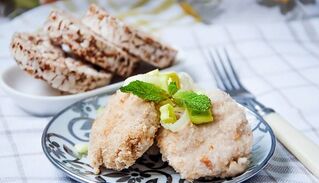
Pancreatitis is a serious disease of the pancreas, characterized by a violation of the production of digestive enzymes. The main symptoms of the disease are pain after eating in the left or right hypochondrium, heartburn, nausea, vomiting and stomach discomfort.
Strict adherence to dietary guidelines is the key to treating pancreatitis. After all, the development of the disease often occurs due to improper lifestyle, consumption of alcohol and "junk" food in large quantities.
The pancreatitis diet helps patients reduce pain during an exacerbation of the disease and add a stage of remission. In acute and chronic pancreatitis, the diet is different, but there are some similarities. Let's talk about them.
General dietary rules for pancreatitis
The main requirement of the diet is to increase the amount of protein consumed and to reduce fats and carbohydrates in the main diet (if possible, they should be eliminated completely). You should especially give up the consumption of granulated sugar because it is 99% carbohydrates.
Fatty foods high in coarse fiber should disappear completely from the lives of patients with pancreatitis. Eventually, they put a heavy strain on the pancreas, as a result of which the body begins to produce very large amounts of digestive enzymes, which is dangerous in this disease and can lead to serious complications.
Doctors recommend that all patients with pancreatitis take vitamin complexes that will help fill the deficiency of vitamins and minerals in the body, often as a result of limited nutrition.

Meals should be planned at the same time.
Eat 5-6 times in small portions a day to avoid excessive stress on the pancreas and overeating.
Diet for acute pancreatitis
As a rule, acute pancreatitis manifests itself as a sudden sharp pain in the stomach pit. The pain is unbearable and therefore forces a person to call an ambulance. The diet for acute pancreatitis before the doctor's arrival is "zero". Under no circumstances should you eat food. Neither "light" nor "heavy".
Before the arrival of the doctor it is allowed to take still mineral water, but not more than 3 glasses. And you are allowed to drink them only if the process of urination is normal.
Treatment of acute pancreatitis is performed only in a hospital setting. The first two days the patient is prescribed on an empty stomach. Only now it is allowed to drink rosehip broth together with mineral water. The total amount of fluid consumed should not exceed 5 glasses per day.
On the third day of treatment, the patient is allowed to eat fresh, low-calorie food that does not contain substances that irritate the pancreas and improve the secretion produced.
Once the main symptoms have subsided, the diet for pancreatic pancreatitis lasts one to two months. During this period you must completely abandon:
- fried and fatty foods; muffins and pastries; pickles and smoked foods; pickles and canned food;
- spicy and sweet;
- onions and garlic;
- alcoholic beverages;
- fatty meats and fish;
- sausages.
All food must be cooked. They must be boiled in water or steam. Do not use oil, salt and spices during cooking.

The patient has the right to eat food only in warm and grated form. Before going to bed it is recommended to use laxative fermented dairy products - kefir, fermented baked milk.
Duration of the diet from 6 to 12 months. And it is on how a person will adhere to it that his health in the future depends. If all dietary recommendations are ignored, the disease can take a chronic form and then the patient will have to be treated for life.
Diet for chronic pancreatitis in remission
The diet for chronic pancreatitis is slightly different from the above diet. In this case, the patient's diet is significantly expanded, but only in remission. During the exacerbation, the diet is of a completely different nature, but for this a little later.
In chronic pancreatitis, the consumption of proteins is allowed, which in practice should exceed a person's daily intake, and the use of carbohydrates (sugar, honey, bakery products, baked goods, etc. ) is also allowed.
Foods that irritate the pancreas (hot spices, large amounts of salt, alcohol, etc. ) are the limitation.
The patient's diet should also be partial. The number of meals is 4 to 6 times. The food served should be warm. It is not necessary to grind food before eating it.
Meat and fish products should not contain much fat, otherwise it can cause liver degeneration, which occurs quite often in chronic pancreatitis. Cottage cheese contains many useful substances and therefore should simply be present in the patient's diet. However, you can eat only homemade cottage cheese, but not very greasy. Store cottage cheese is forbidden to eat.
If a person cannot refuse bread, it is recommended to use during a meal or yesterday's cakes or biscuits (only from gray or black bread). You can also eat baked goods and pastries, but in limited quantities (no more than one serving per day).
In case of pancreatitis, it is not recommended to drink pure milk, as it is poorly digested. It can be added to teas or made into cereals and soups. Even if the patient tolerates milk well, it should not be drunk in large quantities. The maximum dose is 200 ml.

Fermented dairy products are very useful for people with chronic pancreatitis. Even cheese, which in other stages of the disease is on the list of forbidden foods, can be consumed in remission, but not in large quantities and provided that you feel well. The cheese should not be too salty or greasy.
Eggs cannot be eaten whole. Only egg white may be present in the patient's diet. It can be used to steam steamed omelets or added to soups.
The patient's diet should not be high in fat (no more than 70 g per day). In addition, most of them should consist of vegetable fats. They are better absorbed and do not burden the pancreas.
Diet for chronic pancreatitis during exacerbation
The diet for pancreatic pancreatitis during exacerbation is the same as for the acute form of the disease. The patient is prescribed fasting and in case of positive dynamics he is allowed to eat fresh and low-fat food in small quantities.
If no deterioration in health is observed, the patient's menu is gradually expanded. After 2-3 months, a person can eat in the same way as in the remission phase.
Remember that this is just a rough diet for pancreatitis. The complete list of permitted and prohibited products should be checked with your doctor. Only he will be able to compose the right diet, taking into account your health.













































































